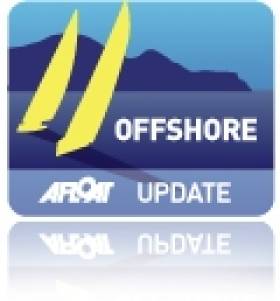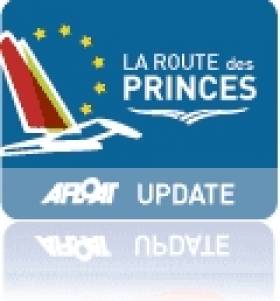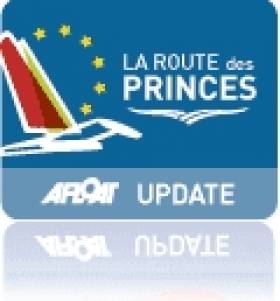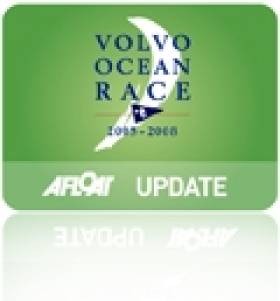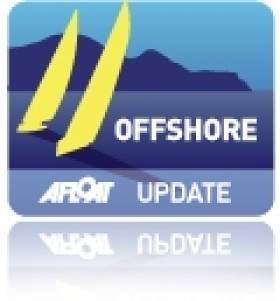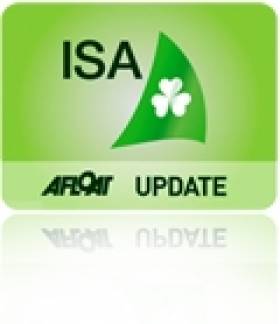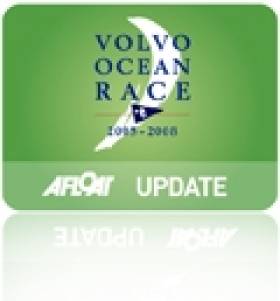Displaying items by tag: Damian Foxall
Route Des Princes – Foxall Podcast from the Fastnet Rock
#routedesprinces – Damian Foxall leads the Route des Princes race this lunchtime, rounding the Fastnet rock to get his first glimpse of home in several months. [Scroll down the page to listen to the podcast].
From on board Omansail, Foxall says he can see the 'green fields of southwest Cork' (not quite Derrynane tho, Damian, eh?) as the trimaran flies along at 28-knots.
The Kerryman's slender lead is threatened this afternoon by light winds and a closing multi fleet as they head for the Tuskar Rock at Wexford.
Omansail are preparing for light winds and a difficult 24 hours ahead.
After a fast and frenetic ride through the North Atlantic, Oman Air-Musandam moved into the lead of the second offshore leg of the 2013 Route des Princes during the early hours of Tuesday morning stretching out a small gain in an incredibly tight contest.
After a fast and frenetic ride through the North Atlantic, Oman Air-Musandam moved into the lead of the second offshore leg of the 2013 Route des Princes during the early hours of Tuesday morning stretching out a small gain in an incredibly tight contest.
Since they left Lisbon on Sunday, the four MOD70 trimarans have been neck and neck, with anything up to 15 miles between them but at the last position update, Oman's flagship boat had eked out a 12 mile lead over the three other boats who were separated by just five miles.
As predicted, conditions have been rough but according to Oman Air-Musandam's Damian Foxall, not as bad as expected.
"It has been pretty bouncy which we were expecting but we have also had some beautiful sailing out here," he said.
"Currently we are going fast upwind doing about 23 knots and are about two hours from the Fastnet Rock. After we round the Rock, anything could happen because things are expected to go light and there could in effect be a race restart."
The Fastnet Rock is about eight miles off the south west tip of Ireland and is familiar to all serious offshore sailors, whether professional or recreational, since it marks the turning point in the classic bi-annual offshore event, the Fastnet Race from Cowes to Plymouth.
When the Route des Princes fleet round the Rock, they will head north towards Dublin rather than south to Plymouth but this is likely to bring new challenges of a lighter breeze, Foxall said.
"At the moment we are concentrating on defending our lead so we have an advantage when things slow up. It looks like things will be slow working our way up the coast to Dun Laoghaire and at the moment it's not obvious whether local knowledge is going to be a factor or not."
If local knowledge comes into play, Oman Air-Musandam will be at a distinct advantage since Foxall is Ireland's leading offshore sailor, having learned his sailing in County Kerry and spent his early years racing round Ireland's coastlines.
At this stage, Foxall said, it was impossible to tell from the weather how the approach into the finish at Dun Laoghaire, around 250 miles away, would pan out but they were looking at an ETA of around 0700 on Wednesday.
For Omani sailor Fahad Al Hasni, the proximity of the racing has brought the best out of the Oman Air-Musandam crew.
"We decided to go further west last night which wasn't the most obvious routing but so far it worked out really well for us and we are now in the lead," said Al Hasni.
"We'll have a tough job trying to defend this over the next 250 miles but we are really looking forward to it."
Full transcript of podcast:
Damian Foxall (IRL, Oman Air-Musandam): " Last night was pretty nice conditions. Actually thinking back it was very nice conditions, not too rough. We were beating up the western approaches on the wind with a westerly current coming down the west coast and an NE'ly flow coming down the Irish Sea. So fairly early we decided we would favour the left hand side, we would be in the left hand shift approaching Fastnet, and the other guys went the other way. So we basically stepped off a little more to the left this morning to cover them. So we were shy reaching into the Fastnet in good conditions, but had a little bit of a scare – well not a scare but a little bit of a stressful moment before the Fastnet when we we were doing about 28kts and the rudder popped up. It must have hit something soft, like a Sunfish or something, but no stress, we slowed down and put it back in place. These central rudders are designed to kick up and so it was fine. Now it is going really light as we go around the Fastnet and the trick is when we start going NE whether everyone is going out into the SE'ly to try and step across. In the meantime all is going well. It is great to see the green fields of SW Cork and to see the Fastnet this morning."
On being only Irish sailor in fleet and passing Fastnet in the lead?
" I think I said thank you to Sidney this morning. I certainly don't take these things for granted. I am very privileged first of all to be racing these boats and also most importantly to be leading the fleet around Fastnet. And of course taking valuable points. Spindrift have got points from the Cascais mark, and we picked up this one. But there is meant to be a race re-start and we can see all the other boats around about us, so it does not really mean too much. We are trying to hang on in what is going to be a very difficult final 24 hours or so, round the SE coast and up the East coast of Ireland."
#TransatJV – Kerry's Damian Foxall will use this week's Irish stop of the Route des Princes Multihull race to announce his next International offshore sailing campaign.
The new venture by the Irish Volvo Ocean race winner and his French skipper Sidney Gavignet is expected to be confirmation of an Omani sponsored entry into November's Jacques Vabre Transat race, but details are under wraps until Foxall reaches home waters.
Foxall and Gavignet are currently at sea, plotting a course into Dublin Bay and Dun Laoghaire early on Wednesday morning, as leaders in the MOD 70 division of the Route des Princes round Europe race.
The two handed announcement – if confirmed – marks a return to a race for the Irishman that ended badly for Foxall eight years ago in the grip of an Atlantic storm when sailing with co-skipper Armel Le Cléac'h in a 60-foot trimaran that capsized.
Foxall was hospitalised after being airlifted from the Foncia trimaran, 450 miles off the coast of France when his 2005 bid for race honours in the famous transatlantic race went horribly wrong.
Foxall put the accident behind him and three years later went on to win a stunning international double–handed victory in the 2008 Barcelona round the world race with Jean-Pierre Dick, a French skipper also bidding for Jaques Vabre honours this November.
Details of the 20th edition of the Le Havre based race are to be announced at a press conference on Friday at the National Yacht Club in Dun Laoghaire. Co. Dublin, the base for the multi's Dublin stop–over.
November's biennial Transat Jacques Vabre follows the historic coffee trading route between France and Brazil.
The course was drawn up back in 1993 to follow in the wake of the clippers transporting coffee from Brazil to France.
The event is open to multihulls and monohulls from the following classes: ORMA, IMOCA, Class 2 Monohulls,Open 50 Class and Class40. There is currently no Oman entry on the Transat Jacques Vabre site, but Team Oman are now listing the transat event on its 2013 programme.
Storms caused havoc for the 2005 Transat Jacques Vabre fleet, survival became the name of the game after seven separate incidents including the capsizes of Foncia and Orange Project triggered a major Atlantic air-sea rescue operation.
Official PR:
Oman Air-Musandam skipper Sidney Gavignet has selected Irishman Damian Foxall as his co-skipper on the Oman Sail MOD70 trimaran in the two-handed 2013 Transat Jacques Vabre in November.
Oman Air-Musandam skipper Sidney Gavignet has selected Irishman Damian Foxall as his co-skipper on the Oman Sail MOD70 trimaran in the two-handed 2013 Transat Jacques Vabre in November.
Foxall, Ireland's leading offshore sailor, has been a key member of Gavignet's MOD70 crew since the start of 2013 but his experience in racing the world's oceans goes back 30 years and covers a remarkable 350,000 nautical miles on the race track.
Of his last three Round the World races, he has won two of them, most recently as watch captain on Groupama in the 2011-12 Volvo Ocean Race.
And four years previously he won the two-handed Barcelona World Race 2007-08, which when added to 18 trans-Atlantics and seven circumnavigations – including two speed records with Steve Fossett's Cheyenne – puts him in a strong position to team up with Gavignet for a bid on the coveted TJV title.
"I have already done a two-handed trans-Atlantic with Sidney when I was on the Figaro circuit at the start of my career in 1997. We have done a lot of sailing with each other and against each other; we get on well and have complementary skill sets," said Foxall.
Four MOD70s are due to line up for the start of the Transat Jacques Vabre on 3 November 2013 for the race from Le Havre to Itajaii in Brazil with Gavignet and Foxall set to do battle with the three boats they are currently competing against in the Route des Princes.
Racing with just two crew however, as opposed to six, presents a whole new set of challenges.
"These boats are not designed to be sailed by two so it will be a handful, a big challenge" Foxall said.
"Apart from the autopilot there is not much about this boat that lends itself to short-handed sailing. It's a lot of boat to handle for two people but Sidney is used to that and I have done a few two-handed races.
"We have a good chance of doing well but it is a heck of a machine to control. We need to know when to push hard and when to ease off while keeping performance levels high."
Gavignet said Foxall was a natural choice as his co-skipper though as the leading skipper for Oman Sail, a national initiative that uses the power of sport to contribute to the development of the youth of Oman, he gave serious thought to racing with his MOD70 Omani teammate Fahad Al Hasni, who is one of the programme's most promising athletes.
"Fahad is one of our top Omani sailors and has made huge leaps in his learning but it is too soon for him to race a MOD two-handed, he is progressing very well and this will certainly come sometime in the future. For me asking Damian was a no brainer because he has so much experience in racing multihulls offshore and we have double-handed experience together which was a very good memory."
Oman Sail CEO David Graham added his support to the crew choice: "The Transat Jacques Vabre is one of the most challenging offshore races in the world and, departing from France, is a natural choice for our sponsors Oman Air and the Ministry of Tourism of Oman who see the event as an ideal platform to communicate with their target audience.
"The choice of Damian Foxall as co-skipper makes Oman Air-Musandam a strong contender for the 2013 Transat Jacques Vabre. Over the past few years, he has gained a reputation that places him at the top of any skipper's 'must have' crew list when planning a demanding offshore challenge.
"Both Sidney and Damian have been highly impressive in teaching and developing the skills of our young Omani sailors so we are confident of having our own Omani representation in these signature short-handed events in the near future."
The Oman Sail MOD70, Oman Air-Musandam, is sponsored by Oman's national airline Oman Air and supported by the Ministry of Tourism of Oman.
Wayne Pearce, Chief Executive Officer of Oman Air, added his enthusiasm for the partnership: "In line with Oman Air's mission of promoting in-bound tourism to Oman, the national carrier is proud to be associated with Oman Sail, which positions the country at the highest possible level of elite discerning travellers."
Since Oman Air was founded in 1993, its network of services has expanded to include a range of the most attractive and fascinating destinations across Europe, the Middle East, Africa and Asia. And with each route originating in Oman, Oman Air is playing a major role in increasing the number of travellers to the Sultanate and providing a thriving gateway for business and tourism.
Foxall's Route Des Prince Campaign is Underway
Damian Foxall's campaign for the inaugural Route des Princes title got underway today on Oman Air-Musandam's when the flag went up on the start line in Valencia against a backdrop of cheering crowds.
All four 70 foot trimarans, including Oman Sail's flagship MOD70, lined up alongside the four Multi 50s and a Maxi 80, making for a spectacular sight for the crowds who watched from the beach at Malvarossa.
"We should see some wind in the early stages so it should be fun and we are looking forward to it," said Foxall as the crew docked out at the Marina Real Juan Carlos ahead of the 800nms leg to Lisbon, Portugal.
"We had a good offshore race with Groupe Edmond de Rothschild in the ArMen Race a couple of weeks ago and are pretty comfortable with our speeds so I think once we get offshore we will make good progress.
"It is important we don't miss any tricks on this or any of the legs. If we get a transition that we miss by a couple of minutes it could cost miles straight away. Even if it is a three or four day leg, we have to treat it like a sprint and we will."
Months of training have underpinned the crew's confidence in their offshore performance but the size and power of the MOD70s mean that success will come down to smooth manoeuvres and minimizing errors, according to Neal McDonald, who will share helming duties with skipper Sidney Gavignet.
"This is a big challenge," he said. "These are short but difficult legs. The only bit I would call offshore sailing is the stretch from Lisbon to the Fastnet rock. The rest of it is coastal sailing so there will be a lot of headlands and corners to turn and tricky moments so sleep will be a no-no. It will be hard to pace ourselves and get into a rhythm. There will be lots of sail changes but this will also bring plenty of opportunities to make gains. It's going to be pretty intense.
"There are some incredibly talented multihull sailors in this race who have been doing this for a long time though we have put in a lot of time into our training.
"We have to keep our errors to a minimum because they get compounded and cost you more and more. The boats that don't make mistakes will extend and extend."
With Mohsin Al Busaidi back in Oman attending the birth of his child, the six-strong Oman Air-Musandam were looking to Fahad al Hasni for some classic Omani inspiration and after spending four years now with the elite flagship programme, he was raring to go.
"This has become a very strong team and we are all confident that we can put in a good performance in this fleet of MOD70s. I'm looking forward to helming in any or all the conditions we come across but my main job will be trimming sails," said Fahad.
"We have prepared well and feel strong. We will be racing for between three and four days which means eating the freeze-dried food.
"It's going to be a hard race but we are all competitive and want to win so will be doing our best right from the start," he said.
Racing starts at 1400. The Route des Princes is an around Europe race from Spain to Portugal, Ireland, the UK and finishes in Northern France.
The first edition of the Route des Princes, a new European Tour which is solely for racing multihulls, will take on a challenging new course over three weeks of racing, starting on June 9th from Valencia in Spain to the Bay of Morlaix in France via Lisbon, Dun Laoghaire and Plymouth.
Irish interest will be in the MOD70 Musandam Oman-Air where Irish offshore sailor Damian Foxall will be part of the crew. Damian is one of the world's leading offshore sailors and has sailed around the world a remarkable 9 times and has won both the Barcelona World Race and the Volvo Ocean Race.
The nine multihulls led by the flagship new Maxi 80 multihull Prince de Bretagne will arrive in to Dun Laoghaire Thursday 20/Friday 21 June depending on weather conditions. The race seeks to mix exciting competition on the water with engaging activities and festivals ashore. The host organisations are Dun Laoghaire Harbour Company, Dun Laoghaire Rathdown County Council and the National Yacht Club who will host a festival on the East Pier from Friday to Sunday.
The festival in Dun Laoghaire will start at 5pm on Friday 21 June with a concert from the Band Stand on the East Pier and will continue until Sunday 23 June with food courts and childrens amusements. On Saturday 22 and Sunday 23 June, the multihulls will race in the bay from 2pm to 5pm and there will be live commentary from Irish Olympic sailor Ger Owens.
The concept of this new yacht race is unique: associating the maritime and the land, by highlighting the town and the region's food and culture at each stopover. Valencia, Lisbon, Dun Laoghaire, Plymouth and Roscoff, five stopovers, five European countries, where those multihulls competing in the Route des Princes will tie up to the dock.
The tour starts in Valencia on June 9.
#VOR - The Volvo Ocean Race team caught up with Ireland's own Damian Foxall on board Sidney Gavignet's MOF 70 yacht Oman Sail with fellow VOR veteran Neal McDonald.
As reported in March on Afloat.ie, Ireland's top offshore sailor - and watch-leader for last year's VOR-winning team Groupama - is part of an international crew that attempted to break the Round Ireland speed record that was unfortunately abandoned due to the harsh wintry conditions.
But Foxall vowed that a repeat attempt is on the cards, and tells the VOR website that his experience on Oman Sail "is exactly what I wanted to do after the Volvo. I just wanted to sail with a smaller team of friends, racing with a good crew."
He added: "Sidney, Neal and I have been sailing and working a lot together. It’s a very natural thing and it’s a pleasure.”
Foxall also sings the praises of the MOD 70 one design, heralding the future of the Volvo Ocean Race and the new VOR 65 yacht.
"It’s light in terms of logistics and repairs. On the water too, I’m looking forward to enjoy the best of the One Design sailing – the battle on the water and not in the boatyard."
Round Ireland Speed Sailing Record Times
#roundirelandrecord –The idea that sailing round Ireland could be sport would have seemed crazy not so very long ago. Ireland's Atlantic coasts, indeed all Ireland's coasts, were seen as the sole preserve of a skilled and hardy breed, very special seafarers who were the only people able for the dangerously hard work made necessary by the need to make a living from fishing, commercial shipping or naval duties on some of the most restless water in the world.
Maybe we're getting back to that stage, with the professional crew of the MOD 70 Musandam – including Ireland's Damian Foxall - lining up today to take on the still impressive 44 hour round Ireland sailing record set back in September 1993 by Steve Fossett's superb 60ft trimaran Lakota. For they're doing it at a time when winter is refusing to loosen its grip, and the radio stations are broadcasting continuous weather warnings. Sail around Ireland? You wouldn't even have let the dog out of the house yesterday.
Yet at least we now know that it is possible to sail the 704 miles round Ireland at high speed and survive – and sometimes even enjoy it. But in the days when Ireland's Atlantic seaboard was known only to professional seafarers and locals scraping a living with small boats which hoped to scuttle back to shelter when storms threatened, it had a fearsome reputation. It was a viewpoint which those who sailed its waters had a vested interest in encouraging and preserving. It rightly made them heroic to others, while the jealously guarded navigational knowledge of local pilots was something which gave them a useful economic advantage.
In the late 19th Century, however, the spread of recreational sailing inevitably led to cruising yachtsmen sailing to ever more remote coastlines. Mostly they were affluent types whose boats were managed by professional captains. But in time the sportsmen were sailing their own boats, with amateur cruising under sail becoming a whole new branch of yachting. And there had long been yachts on the west coast of Ireland. In the briefly prosperous pre-famine era, the Royal Western YC of Ireland in 1838 listed 18 members' vessels of varying sizes based at its home port of Kilrush in County Clare. So the likelihood is high that some of them sailed round Ireland, even if only on delivery trips by professional crews.
But the earliest specifically round Ireland cruise from an Irish port that we definitely know of didn't happen until 1889, when Walter Boyd of Howth skippered his own 34-ton yawl Aideen round Ireland. Better known as Judge Boyd, Aideen's amateur skipper was a classic Dublin character – he's referenced in Joyce's Ulysses – but his enthusiasm for cruising Ireland's more rugged western coastlines was usually not shared by fellow yachtsmen, even if he did his best to spread the word that it was by no means as scary as popular opinion would have it.
We know little of Boyd's cruise, except that he did it and he must have sailed all the way. It wasn't until 1896 that we have the log of a round Ireland cruise which enables us to give some sort of guess at speed. Of course, the idea of sailing round Ireland non-stop was a complete non-runner until the Round Ireland Race was inaugurated from Wicklow in 1980. But in 1993 it was realised that Lakota's sensational new time was such a game changer that it was important to record the early pioneers before this new wave of multi-hull hyper-speed swept their memory away completely.
Thus it was that, 97 years after he wrote it, the number crunchers fell upon Belfast doctor Howard Sinclair's charming log of his clockwise cruise round Ireland in 1896 in the 30ft cutter Brenda. They worked out – after making allowances for time taken to get in and out of ports and anchorages – that he had averaged 2.63 knots. There were few enough eligible round Ireland circuits after that, for the advent of the auxiliary engine rendered most of the only very slowly increasing number of round Ireland cruises invalid as pure sailing projects. But in 1935, the speed improved slightly when Humphrey Barton – later founder of the Ocean Cruising Club – made an anti-clockwise cruise from Belfast Lough at an average of 3.34 knots in the engineless 37ft gaff cutter Dauntless.
Belfast Lough figures surprisingly prominently in these early round Ireland sailing chronicles. Perhaps it's because, of all the major Irish sailing centres, Belfast is furthest from the choicest cruising area in southwest Ireland. It's as quick for the Belfast men to sail home from Kerry by going on round, whereas Dublin Bay boats are heading further away from home until they reach Slyne Head up in Connemara, and Cork boats seldom if ever sailed round Ireland at all until Denis Doyle came along and cut a mighty swathe with Moonduster.
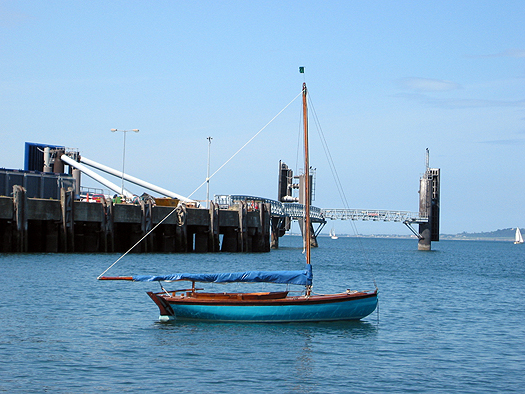
The mighty atom. The Belfast Lough Waverley class sloop Durward is just 18ft long. Yet in 1961 (when setting a Bermudian rig) she sailed round Ireland at an average speed of 3.4 knots. Photo: W M Nixon
Whatever the reason, the next two cruises which increased the average speed both also started from Belfast Lough. Truly remarkable in 1961 was the speedy clockwise circuit by the 18ft Belfast Lough Waverley Class Durward, still the smallest keelboat to have done it, and a record which is likely to stand as keelboats rarely get any smaller. In those days, Durward (which is now based in Dun Laoghaire) set a handy Bermuda rig, whereas today she has changed to the gunter rig as originally designed, with a remarkably long mainboom. On the circuit in 1961, for which her cockpit was fitted with a temporary lid to mke a sort of cabin, she was sailed by brothers Kevin and Colm MacLaverty, with Mick Clarke as third hand, and their average speed with this gallant micro-cruiser was 3.4 knots, very good going with a 14ft waterline.
The average speed finally got above 4 knots three years later in an unintended anti-clockwise sailing circuit. We (this blogger, together with Russell O'Neill and Ed Wheeler) set out in 1964 in the vintage 36ft yawl Ainmara with every intention of availing of the engine as often as needed. But it seized solid before we'd even got clear of Belfast Lough, so it was sail all the way for an average of 4.83 knots which would have been around than 5.4 if we hadn't had to spend a long night lying a-hull in a southerly gale somewhere off the mouth of the Shannon.
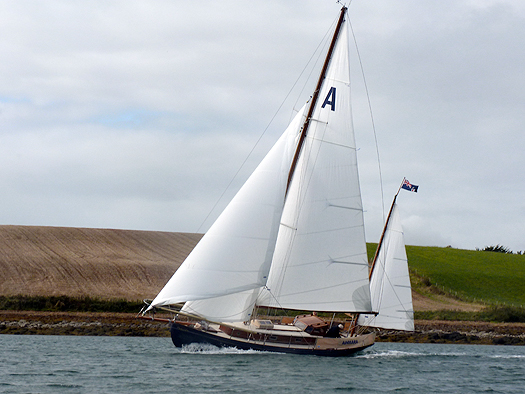
Ainmara, 101 years old, is currently owned by Dickie Gomes, who established a round Ireland record with the trimaran Novanet in 1986. But Ainmara was herself an "accidental" record holder, back in 1964 Photo: W M Nixon
By the 1970s, Round Ireland Races were coming up the agenda, so the record analysts of 1993 had something more tangible to go on. The first round Ireland race was a clockwise three stage two-handed event from Belfast Lough staged by Ballyholme YC, with stops in Crosshaven and Killybegs. Winner was the Dun Laoghhaire S&S 34 (Robert Mollard & Dick Watson), and with many light weather days, they averaged 4.95 knots. Five years later, the pace quickened with the first non-stop Round Ireland Race, clockwise from Wicklow in 1980, and the line honours winner, Johnny Morris from Pwllheli with the 36ft Force Tension, averaged 5.24 knots.
Then, The Doyler arrived with The Duster, and the numbers started to get interesting. The great Denis Doyle of Cork is gone from us now for a dozen years, and many of today's younger sailors can scarcely be aware how this most modest of men, with his lovely Crosshaven-built 1981 Frers 51 Moonduster, so greatly enhanced Irish sailing. And never more so than in his final twenty years, when he and Moonduster played a central role in the European offshore racing scene.
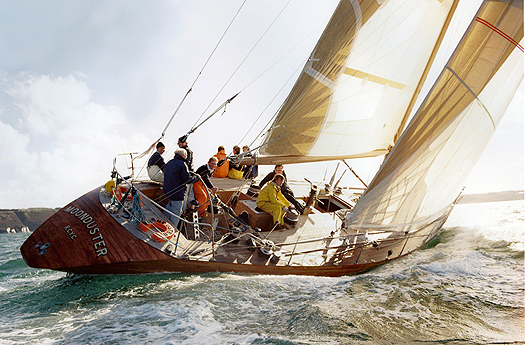
The queen of all fleets. Denis Doyle's legendary Moonduster was the flagship of Irish offshore racing for twenty years. Photo: Bob Bateman
Once The Doyler had decided that the Round Ireland Race and Wicklow deserved his support, he gave it so wholeheartedly that today it receives the same points weighting in the RORC championship as the Fastnet Race itself. Oddly enough, though, Moonduster's two record times in the Round Irelands of 1982 and 1984 were so good that the challenge they posed moved the round Ireland record beyond the Round Ireland Race. For the Round Ireland Race is of course narrowed to a specific starting time, and you have to go clockwise. But after Denis Doyle had pushed his own average speed to 7.09 knots in 1982 up to 8.02 in 1984, inevitably speed sailors began to wonder just how fast you might go with choosing you own optimal starting time, and carefully selecting which way to go.
For there's no doubt that Moonduster's performance in 1984 was a real beauty. The wind was west to nor'west, with enough north in it to comfortably lay down to the Fastnet, and then only the briefest bit of sailing hard on the wind before it backed slightly and they were off on a hack up the west coast. As navigator John Bourke puts it: "We were seeing off an entire Irish county in every watch".
An average of 8.02 knots may seem little enough compared to today's massive multi-hull speeds. But for an amateur-crewed mono-hull sailing at a pre-ordained time on a land-circling course in a region of weather ranging between variable and volatile, it was quite something, and a challenge to all-comers. So although the Round Ireland Race itself continues to have its own monohull record time (it's currently held by Mike Slade's 100ft Leopard from the 2008 race), since 1986 the out-and-out Round Ireland Sailing Record has been held by three different multi-hulls choosing their own starting point and time, and which way to go. One of them did it from Belfast Lough, and the other two did it from the Kish Lighthouse in Dublin Bay, which has become the de facto recognized record starting point, as it was also from here that a new Round Ireland Mono-hull Record was established by Jean-Philippe Chomette's Open 60 CityJet in 2006.
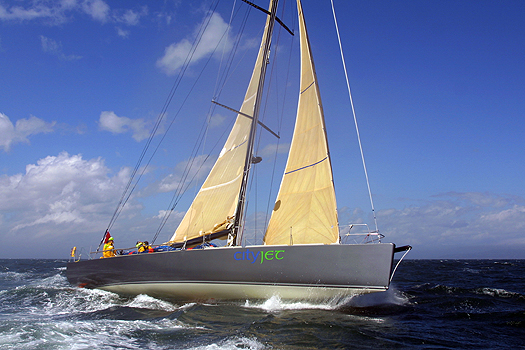
Jean-Phillippe Chomet's Open 60 CityJet set a straight monohull record from the Kish in 2006 Photo: David O'Brien
The weather expert in CityJet's successful crew was noted sailor/meteorologist Chris Tibbs, whose belief that reading the weather right for a round Ireland challenge is one of the most interesting met challenges in world sailing was borne out by the elegant way in which CityJet fitted into a west to nor'west wind pattern to sweep around clockwise in record style, and his analysis of this performance added to the growing knowledge of what's involved.
If you're thinking in round Ireland sailing record terms, first thing is to re-think the shape of the island. The popular perception is that the Emerald Isle is more or less rectangular, with distinctive north, east, south and west coasts, and very clearcut right angle corners at Fair Head, Carnsore Point, Mizen Head, and Bloody Foreland.
Not so, however, if you're in the records business. Anyone contemplating a round Ireland sailing record these days has to think in terms of a jolly green giant tadpole, with its blunt head pointing northeast towards the Inner Hebrides, and the fat tail pointing southwest into the wide blue yonder.
Those who would set a record will plan on as much fast reaching as possible on the longer eastern and western seaboards, and running before the wind around the northern nose, with any slugging to windward as brief as possible around the southerly tail.
So the smart money is on the situation where there's a big low loitering with intent to the southwest of Ireland, and the wind is set for two or three days in the southeast to east quadrant. Just like the last 36 hours, in fact, except that the pressure gradient has been more than a little too steep for record-breaking purposes. But with the isobars easing up a bit this morning, the setup is in place, and the only way is anti-clockwise. That said, there's a small concern that tonight might see a localised southerly twist down towards Mizen Head. But that should have gone back southeast by the time Musandam is getting there, and with any luck they might even get by with just the one tack sou'west of the Fastnet, though windward tacking is not the same problem with the Mod 70s as it was with some of the earlier multi-hulls.
In taking on the round Ireland challenge, it may well be that the alternative winning option of a west to nor'west wind occurs more frequently, which would dictate a clockwise route. But a nor'wester usually doesn't last as long, whereas the rarer sou'east to east wind can settle in for days. Or at least it seems like that at this time of the year, when it's bringing us the tail of Siberian weather, and would drive you nuts if you didn't have some worthwhile project like a round Ireland record on hand to make good use of it.
Of course, a crazily ideal situation might seem to be an intense low stuck right over the middle of Ireland, and you whirl round anti-clockwise, broad reaching on port gybe all the way. It's an interesting gambler's option, and it has succeeded in the past. But maybe it's too unstable a weather situation for serious record-breaking nowadays, because if the low is sufficiently intense to have strong winds all round its core to power the entire coastal sailing route, it can sometimes quickly fill and leave you becalmed, as low pressure areas lose power over the land. But if it does persist, even having its centre move just 50 miles can have the wind all over the place.
No, what you want is a good steady gradient, but not too steep, with winds southeast to east and the occasional bit of luck with slight but significant swings in the wind direction to enable you to make south all the way around the western seaboard without tacking, and east-northeast along the south coast equally free of tacking, once you've weathered the tadpole's tail.
It's a big ask. We can predict the weather fairly accurately a day ahead, but that accuracy is rapidly reducing with every hour beyond the start, when the show up and running and there's no going back. But things are looking good for this new challenge by Sidney Gavignet, Damian Foxall and their shipmates on Musandam, which is now due to start today. Heaven knows, but they could do with a little break. Having left Lorient late Thursday afternoon, they found conditions getting increasingly rugged as they came north, and much of the passage up St George's Channel was under bare poles in a howling sou'easter yesterday, making over to the lee of the Wales and getting into the relative shelter of Caernarfon Bay under snow-covered mountains as evening drew on.
Damian summed it up in a text to Afloat.ie, "A bit bouncy for a start.....shelter in Caernarfon Bay this evening and tonight, nice and flat, chilly though...sleet, snow forecast...option tomorrow morning better, potential start 0900ish. Enjoy your dinner this evening with the family and a bit of telly in front of the fire, we'll be thinking of you ☺"
It was mighty cold, it still is, but spirits were raised with hot food – the first of the day for the skipper and Thomas le Breton. And they have been able to consider their options, with the weather pattern for the next couple of day seemingly fairly clearcut, the wind set in between southeast and east with the occasional slight weaving, which can make a lot of difference at difficult headlands. But with the wind forecast to become locally east to northeast along the south coast between the Fastnet and Carnsore Point on Monday morning, they know they've got to be up and moving promptly this morning if they're going to knock the record for six.

Robin Knox-Johnson's 60ft catamaran British Airways developing power off Dublin Bay at the start of her round Ireland challenge in May 1986. She came within an ace of capsizing a few seconds later, but then streaked away northeastward on a successful anti-clockwise circuit. Photo: Tom Lawlor
So what are the three previous multi-hull records they're taking on? Well, after Denis Doyle's definitive round Ireland speed of 8.02 knots in 1984, Robin Knox-Johnson was first into the fray with his 60ft Rod MacAlpine-Downie designed catamaran British Airways in May 1986. Compared to today's minimalist multihulls, with her acres of deck she now seems like an overbuilt aircraft carrier. But 27 years ago when we joined her in Plymouth to bring her up to the National YC in Dun Laogahire, who were organizing the first challenge using the Kish as the start and finish point, she seemed quite the business.
A period of southeasters was in prospect, but we'd some tense waiting around until things looked about right, then we slugged out to the Kish, and in plenty of breeze let her at it with rather too much enthusiasm. The weather hull had a mind of its own, and flew up.....and up - we were within an ace of capsizing. But down it came again, that wayward weather hull, and we shot up the Irish Sea, westward round the nose of the tadpole like a rocket, then on south at high speed on course towards Kerry. But the wind veered about twelve hours too soon, and we were plugging to windward in lumpy seas from north of the Blaskets all the way down to the Fastnet. So though we'd proper yachting, spinnaker and all, from the Fastnet to the finish, we only just edged over the Doyler's time to push the average speed up to 9.21 knots.
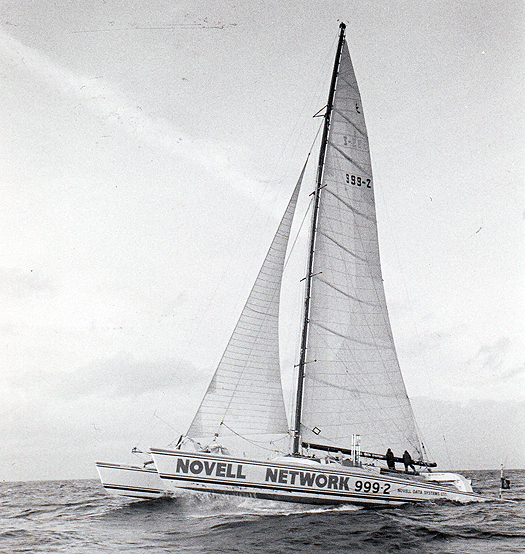
She was a brutal big beast. The 83ft Novanet was 40ft beam, heavy to handle, and very reluctant to tack. But she set a new record in November 1986.
It was, as our doughty skipper put it, an eminently beatable time. And within four months somebody was trying to do that very thing. In those days, northerner Dickie Gomes (ironically the owner since 1966 of the 1964 record holder Ainmara) had a parallel existence as a multi-hull sailor, and in 1986 he was teamed up with former police sergeant Peter Phillips on the catamaran Novanet.
This was one monster. She was 83ft long and 40ft wide, and it took half a day to tack her when the going was good. But in straight line sailing, she could get up to a merry speed, and in September 1986, with a crew large enough to think of shaping up to sailing this eccentric giant, they set off from Belfast Lough. They went clockwise in a brisk west to nor'west breeze, which had enough north in it to let them lay down to the Fastnet, where things were looking good, as they were still only 20 hours on their way. But then the huge mainsail split, and that was that for the time being.
It was November before they could have another go. If you think the prospect of sailing round Ireland in March is grim, don't even think about November.....fourteen hours of darkness, and the winter winds in crazy mood. But in another west to nor'west wind pattern, it went well until they were past Achill Island in a rising wind and a freezing front went through to cause a crucial veer which made weathering the Black Rock a very dubious proposition. Yet their awkward big boat wouldn't have tacked in the deteriorating conditions. Either they ran her off, probably to beach her, or hoped they'd just enough clearance to scrape by the Black Rock's lethal offliers.

The crew of Novanet after her successful challenge in November 1986 were (front row left to right): Dickie Gomes, Brian Buchanan, Brian Law and Peter Minnis, back row: Peter Phillips, Enda O'Coineen, (Richard Price of Novanet), Paul Hargreaves, Greg Peck and Bob Bradford. Photo: W M Nixon
They still don't really know how they did it. But with maybe only inches to spare, Novanet got past the Black Rock. This slightly freed her to clear Eagle Island and Erris Head, and after that it was off like a scalded cat under headsail only in a Force 10 past Tory and Inishtrahull and Rathlin Island, with the wind veering even further to speed them down to Belfast Lough and a new record average 10.05 knots. At least the Round Ireland Record was finally through the ten knot barrier. But still nothing sensational, you might reasonably think. Yet it stood for nearly six years. However, when it was toppled in September 1993, it was done so in very convincing style.
Con Murphy and Cathy MacAleavy of the National YC were multi-hull enthusiasts who managed to convince new-to-the-scene American sailor/adventurer Steve Fossett that he should bring his decidedly hot 60-ft trimaran Lakota to Dun Laoghaire for an early Autumn crack at the round Ireland record in 1993. Fossett had Dave Scully as his partner in the boat, and they also had up-and-coming multihull star Brian Thompson with them. They signed on Con and Cathy to bring crew numbers up to five, as many as they felt was needed for a boat which in her elegant way was as light as British Airways and Novanet had been heavy.
They'd expected to wait a while in Dun Laoghaire, but as their overall time window was narrow, when a deepening low settled into a course straight at Ireland from the southwest, they decided to ride it almost immediately. Not an ideal scenario nowadays, but don't forget that twenty years ago, they were trying to beat an average of only10.05 knots, and with a slippy boat like Lakota, they could cut themselves a bit of slack.
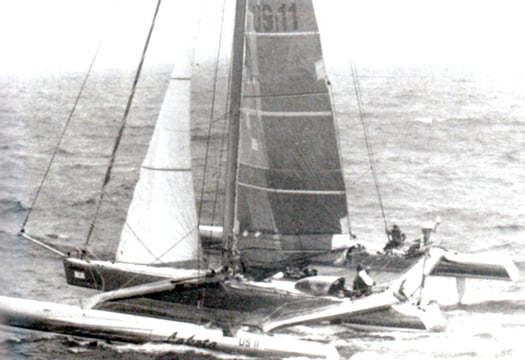
Lovely weather for record-breaking. Lakota sets off in successful pursuit of the Round Ireland record, September 8th 1993. Photo: Air Corps
The conditions when they went off on Wednesday September 8th 1993 were dreadful for yachting, but perfect for record breaking. In a mighty cloud of spray and spume and rain, under shortened canvas, they zoomed north in a horribly wonderful sou'easter. And while the Irish land lay under the heavy rainclouds of this still energetic low, Lakota streaked on past Donegal under clear night skies and south past the coast of Connacht.
Because the weather had been developing so rapidly, this meant that off Galway's west coast they were crashing into old head seas from the southwest which threatened to damage the boat. And the crew too. Con Murphy, trying to grab some sleep in a bunk down aft, found himself hurled forward along the length of the accommodation. It's beyond imagination to visualize the loads created by slamming into seas like this at these speeds, but Lakota held together.
On both the south and west coasts they had to endure the calm patches which almost inevitably develop when you are using a low pressure area centred over Ireland, with the wind drawing off the land. They came to a stop at the Old Head of Kinsale, and then again at Wicklow Head. But quite soon they were going again, and there was time in hand and then some. The Kish was put astern again after 44 hours 42 minutes and 20 seconds an average of 15.84 knots. It's a record which has stood for 19 years, four months and 12 days. Will it still be standing on Monday?
Yes it will! Message received at 07.18 on Saturday:
Dear Chris,
We will not attempt the record this time, we are aiming back to Lorient. Conditions are "almost" ok, but we prefer to play the safe decision.
Hopefully we will come back later in the year, in better conditions. All our team thanks you a lot for all your efforts, we regret we won't see you but it will happen later. Best regards. Sidney Gavignet, Skipper MOD 70 Musandam

The record holders. Con Murphy, Cathy MacAleavy, the late Steve Fossett, David Scully and Brian Thompson, crew of Lakota round Ireland, September 8th to 10th 1993
Comment on this story?
We'd like to hear from you on any aspect of this blog! Leave a message in the box below or email William Nixon on [email protected]
WM Nixon's Saturday Sailing blog appears every Saturday on Afloat.ie
Follow us on twitter @afloatmagazine and on our Afloat facebook page
Track Round Ireland Speed Sailing Record Bid Here!
#roundirelandrecord – Damian Foxall's Round Ireland speed sailing record bid due to start Friday, March 22nd has not got off to the most auspicious start. Battered by strong winds and big waves in the Irish Sea the giant tri under skipper Sidney Gavignet has been reduced to bare poles on its 1000km delivery trip from Lorient, France. The crew is 'on stand-by' and currently looking for shelter on the Welsh coast (1500 Friday) before attempting the Dublin Bay startline. There are unconfirmed reports now that the attempt will be postponed until tomorrow (Saturday). Track the progress of the giant MOD 70 trimaran via the Yellow GPS tracker (above) on Afloat.ie. Remember – once they cross the Dun Laoghaire line 44 hours is the record time to beat! Read WM Nixon's review of all previous Round Ireland speed records dating back to 1899 here!
The Sultanate of Oman's MOD70 flagship Musandam-Oman Sail is due to kick off a busy racing season with this Round Ireland Record attempt but it is only one part of the crew's busy season. French skipper Sidney Gavignet returns to lead the 6-man crew made up of Omani sailors and well-known international pros (including our own Damian Foxall) for a season that will also include the Route des Princes and the Rolex Fastnet Race in August.
Gavignet's new look crew on Oman's flagship Multi One Design 70 Musandam-Oman Sail have brought with them new expectations for the 2013 season as their preparations start in earnest this week with an attempt on the long-standing Round Ireland record.
As part of an intensive three week training programme, the Oman Sail crew, featuring three new faces from last season, will make a bid on the 20 year-old record as a practice run for the team's busy racing schedule later this summer.
The 700-mile sprint through the lumpy Irish Seas and the Atlantic Ocean is sure to be a baptism of fire for one of the new crew, Omani sailor Ahmed Al Maamari who only recently stepped aboard the MOD70.
Foxall Onboard French Trimaran for Round Ireland Record Bid
#roundirelandrecord – A 60-foot MOD 70 trimaran with Ireland's top offshore sailor Damian Foxall and an international crew on board is to attempt to break the Round Ireland speed record this week.
French sailor Sidney Gavignet will skipper Oman Sail, a MOD 70 that was last in Irish waters for the MOD70 European tour last September. As well as Foxall, Neal McDonald, Jean Francois Cuzon and Fahad Al Hasni are listed as crew.
FOR ROUND IRELAND OMANSAIL TRACKER CLICK HERE
The bid is sponsored by the Tourism ministry of Oman.
World Speed Sailing Record Commissioner Chris Moore, who is also the vice-commodore of Dublin Bay Sailing Club (DBSC) will officiate this latest attempt, possibly on March 20th but subject to weather. The plan, according to Moore, is to start and finish at the Kish lighthouse at the entrance to Dublin Bay using DBSC's new starting vessel Freebird.
This latest record attempt at the 700–mile course is 20 years since Steve Fossett's Lakota set the inaugural Round Ireland record. Back then Irish sailors Con Murphy and Cathy MacAleavey of the National Yacht Club were on board the catamaran.
The National Yacht Club is the keepr of records of Round Ireland speed record attempts for solo, monohull and multihull records.
In Early Sept 1993, the 60ft. trimaran 'Lakota' shattered the previous record for the fastest circumnavigation of Ireland by almost one full day.
Sailing with a crew of 5 – American co-skippers Steve Fossett and David Scully, English yachtsman Brian Thompson and Irish husband and wife team, Con Murphy and Cathy Mac Aleavey from the National Yacht Club – "Lakota" crossed the start line at the Kish in Dublin Bay on Wednesday, 8th September 1993 and headed North East, finishing at 09.12 on Friday 10th September, completing the course in 44 hours, 42 mins and 20 seconds, averaging 15.84 knots.
David Andrews, T.D., Minister for Defence and the Marine, presented the Cork Dry Gin Perpetual Challenge trophy for the record to Steve Fossett at a presentation dinner in the National Yacht Club on the 18th November 1993. The trophy remains with the National Yacht Club until there is a successful challenge to beat "Lakota's" time through some other sailing club or national authority.
More details on the current record attempt as we have it. Below some footage of Oman Sail at speed.
Celebrate Irish Sailing At The ISA Awards Ball
#ISA - Supporters of Irish sailing are asked to come together for a night of celebration and pay tribute to some of the outstanding contributors to sailing across six categories including the Mitsubishi Motors Club of the Year, Volunteer of the Year, Instructor of the Year and Training Centre of the Year.
Irish sailing's stars of tomorrow - such as ISAF Youth Worlds silver medallist Finn Lynch - are also in the running for the title of Youth Sailor of the Year.
Last year was an incredibly successful year for Irish sailing: 11 sailors represented Ireland at both the London Olympic and Paralympic Games, dozens of medals were claimed at events around the world and we played host to such high profile events as the ISAF Youth Worlds, the Volvo Ocean Race finale, the Tall Ships Race and the MOD 70s, to name but a few.
The ISA Awards Ball is the occasion to celebrate 12 months of successes and also launch the 2013 season in style. Tickets for the ball are €65 per person and must be booked by Friday 22 February 2013. Full details can be found at the ISA website HERE.
#vor – Kerry's Damian Foxall Groupama team won the 11th edition of the Volvo Ocean Race early this morning when they crossed the finish line in the pitch black Galway night to settle the closest contest in the race's 39-year history.
While CAMPER were celebrating victory in the ninth and final leg, Groupama skipper Franck Cammas led his team home in second place to take an unassailable 24-point lead with just one in-port race to go.
The win for Groupama would be the first Volvo Ocean Race victory for Foxall, who has sailed round the world nine times. The Kerry man hails from Derrynane and had a childhood dream of competing in the then Whitbread Round the World Race.
Foxall is not the first Irish winner, Foxall joins hid former Green Dragon team mater Cork sailor Justin Slattery who was a winner of this race in 2006.
This morning Groupama crossed the finish line at 00:49:11 UTC, just seven minutes behind CAMPER. PUMA finished in third place at 00:55:01 UTC ahead of Team Telefonica, who finished at 00:59:33 UTC.
Cammas, the 39-year-old Frenchman, threw his arms up and pumped his fists in the air while thousands of fans gathered on the dock of Galway Bay to roar the team -- including Irishman Damian Foxall -- home to a remarkable victory in their first appearance in the race.
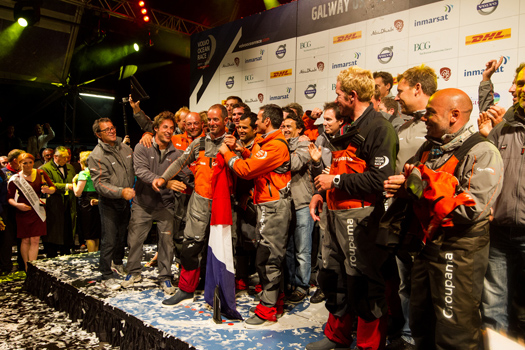
Damian is centre stage for this morning's celebrations
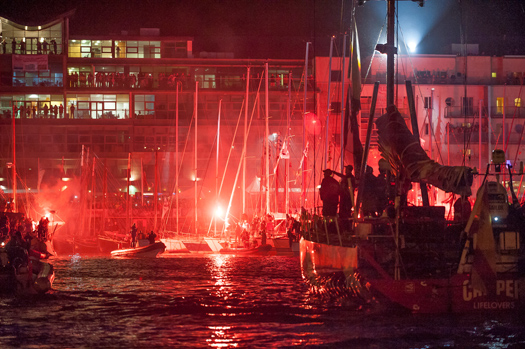
Turning the Galway night sky red. CAMPER with Emirates Team New Zealand, skippered by Chris Nicholson from Australia, arrive to a huge spectator crowd, after winning leg 9 to Galway. Photo: Paul Todd
Groupama are the first team to represent France in the Volvo Ocean Race since Eric Tabarly's La Poste in 1993-94 and they are only the second French winners after Lionel Pean on L'Espirit d'Equipe in 1985-86.
The team gallantly fought back from a deficit that was as high as 28 points following the HaiTang Bay In-Port Race in Sanya, winning the next leg to Auckland and steadily improving their knowledge of their boat and cohesion as a team to surge to a commanding lead going into Leg 9.
With the sort of nerve that quickly became their trademark in the race, Groupama stayed serenely out of trouble on the 550-nautical mile race through wild conditions in the English Channel and around the iconic Fastnet Rock, to finish second across the line and seal their place among an elite band of winners in an event that began life as the Whitbread Round the World Race in 1973.
CAMPER with Emirates Team New Zealand led the procession across the finish line much to the delight of surrounding flotilla of spectators, at 00:42:13 UTC -- their first leg win of the race.
CAMPER are almost certain to secure second place with 226 points, six points clear of third place PUMA, with just the final in-port race remaining.
Six points will be up for grabs for first place, five for second, four for third and so on when the final race of the epic 39,000 nautical mile ocean race starts on July 7.
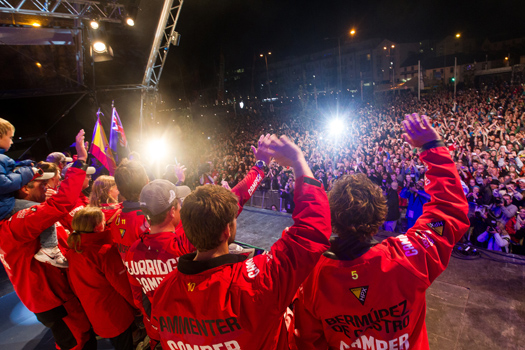
Camper are greeted by a huge crowd this morning
Standings after the final offshore leg:
1. Groupama (France) 250 points
2. Camper/ETNZ (Spain/New Zealand) 226
3. Pima (U.S.) 220
4. Telefonica (Spain) 209
5. Abu Dhabi (UAE) 124 + 5 or 10
6. Sanya (China) 40 + 5 or 10




























